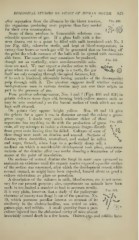Page 815 - My FlipBook
P. 815
BIOLOGICAL STUDIES ON FUNGI OF HUMAN MOUTH. 825
after separation from the albumen by the biuret reaction, Fig. 430.
the organisms producing more peptone than they needed
for their own consumption.
""^^^
"^
Some of them produce in fermentable solutions con- "
siderable quantities of gas. If a glass bulb with a fine
stpui drawn out to a point be filled with milk inoculated with No. 3
(see Fig. 428), otherwise sterile, and kept at blood-temperature, in
twenty-four hours so much gas will be generated that on breaking off
the pi)int the whole contents of the bulb will be ejected with consider-
able force. The same effect may sometimes be produced,
though not so markedly, when non-fermentable solu- ^
a
tions are used. We may expect a similar action to take ^g©^ *
place when we seal up a dead pulp in a tooth, the gas ^^^ @
itself not only escaping through the apical foramen, but,
if its exit is hindered, ultimately forcing particles of the decomposino"
pulp througli with it. The question suggests itself whether certain
configurations seen in carious dentine may not owe their origin in
part to the pressure of gas.
Four produce coloring-matter, Nos. 5 and 7 (Figs. 430 and 431) in
gelatin cultures some days old, forming brick-yellow masses such as
may be seen occasionally on the buccal surface of teeth which are not
kept well cleaned.
On potato they appear bright yellow. Nos. 10 and 13 give
the gelatin for a space 1 cm. in diameter around the colony a grass-
green tinge. I doubt very much whether either of these
organisms has anything to do with the production of green ^^^- ^^^•
"
stain, all my attempts to isolate a chromogenic fungus directly ^, ^
from green stain having thus far failed. Cultures of some of \"v.
these fungi were made on dentine and enamel. Sections of x
dentine, when decalcified, neutralized, and soaked in saliva "^s^
and sugar, formed, when kept in a perfectly damp cell, a
medium on which a considerable development took place, microtome
sections of the dentine after two weeks showing a destruction of sub-
stance at the point of inoculation.
On sections of normal dentine the fungi in some cases appeared to
maintain an existence until tlie organic matter exposed upon the surface
of the section was consumed, after which the development ceased, while
normal enamel, as might have been expected, formed about as good a
.
culture substratum as glass or porcelain.
A description of the cultures in milk, blood-serum, etc. is not neces-
sary for our present purpose ; also, experiments on animals have been
made in too limited a number to lead to accurate results.
It is very plain, however, that a study of the pathogenic
character of twenty-two fungi is out of the question. No.
19, which possesses peculiar interest on account of its
similarity to the cholera-bacillus, was tested on mice,
guinea-pigs, and rabbits. A small quantity from a pure
culture injected into the abdominal cavity of mice almost
invariably caused death in a few hours. Guinea-pigs and rabbits have


